History
Pre-history
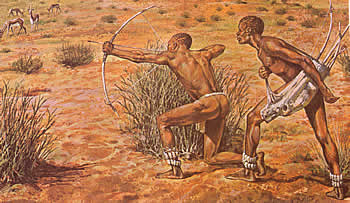 Up to the early 1700's the only human presence in the area was that of the San or "Bushmen", stone-age hunter-gatherers who lived off the land as they had done for millenia and the Khoikhoi or "Hottentots" who were pastoralists.
Up to the early 1700's the only human presence in the area was that of the San or "Bushmen", stone-age hunter-gatherers who lived off the land as they had done for millenia and the Khoikhoi or "Hottentots" who were pastoralists.
The land was totally uncultivated and well-populated with wild animal species, including elephant, lion, leopard, hyena, wild dog, quagga, wildebeeste, eland and many others.
The arrival on the scene of immigrants completely changed this picture and by the 1850's the San had completely disappeared, leaving behind only their rock art and various artifacts to show that they had ever existed.
The migrations
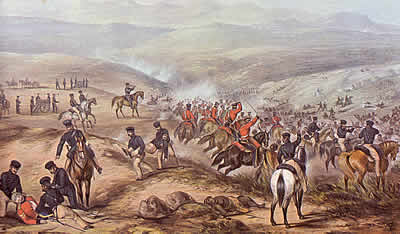
Towards the mid-1700's, two groups of migrants began to infiltrate the area.
From the west came the first trekboers, Dutch pioneers seeking new lands to settle.
From the east came groups of Xhosa, a Bantu-speaking people, displaced by power struggles within the Xhosa nation.
In 1779 the Dutch authorities, trying to limit the expansion of their colony, negotiated with certain Xhosa chieftains and managed to reach agreement that the boundary should run along the Fish River to where Cookhouse stands to-day, then along the top of the Kaga Mountains overlooking Bedford and thence up to the Tarka River.
Bands of Xhosa, however, continued to move west across the Fish River and later in 1779 the first clashes took place between them and the Dutch.
This war ended in 1781 when the Xhosa were driven back across the Fish.
Graaff-Reinet
In 1786 the Dutch authorities founded the village of Graaff-Reinet to head up a district in order to bring the frontier of the colony under control.
Further Xhosa infiltration resulted in a second war in 1793 which resulted in only partial expulsion of the Xhosa.
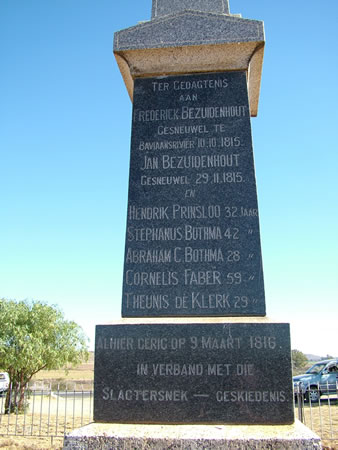
Increasing bitterness between the frontier boers and the authorities in Graaff-Reinet culminated in 1795 with the boers siezing the town and proclaiming a republic.
The coming of the British
The conquest of Holland by the French led to the British occupying the Cape to deny it to the French. This led to the collapse of the self-proclaimed republic.
In 1799 the same group of boers attempted another revolt against the authorities, now the British, but this proved abortive.
The Slagtersnek Rebellion
When, in 1815, the landdros of Somerset East attempted to arrest a boer for contempt of court and, while resisting arrest, the boer was shot, some of the disaffected boers of the area again rebelled. This rebellion was quickly and severely suppressed by Colonel Jacob Glen Cuyler, an American in the British army, who hanged five of the rebels at Slagtersnek.
This hanging became something of a cause célèbre as four out of five of the ropes broke. Despite the popular belief that this was an act of God, Cuyler sent away for fresh rope which caused a delay of several hours before the remaining four were hung for the second time.
More Frontier Wars
The continued occupation by the Xhosa of the Zuurveld (the area between the Sundays and the Fish rivers) led the British in 1812 to mount an expedition which drove the Xhosa back across the Fish.
In 1819 the Xhosa mounted an invasion of the Zuurveld which resulted in their defeat at the battle of Grahamstown and their being driven once again back across the Fish.
The 1820 Settlers
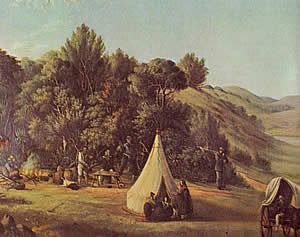 It was decided to strengthen the frontier by populating it with settlers from Britain.
It was decided to strengthen the frontier by populating it with settlers from Britain.
In 1820 numbers of English and Scots arrived. The Scots were settled in the Baviaans River Mountains, on land confiscated from the Slagtersnek rebels while the English were settled in the Albany district to the south.
Following the 1819 war, the British had obtained the cession of the area between the Fish and Keiskamma Rivers as a buffer zone, intended to be a neutral zone subject to garrison and patrol by the military.
This neutrality began to break down the following year with the introduction of white settlers into first the mountainous northern area of the zone and then into the Bedford flats while, on the other hand, the Xhosa re-occupied the Kat River valley.
In 1834 some 15,000 Xhosas invaded the colony and caused widespread devastation.
The Great Trek
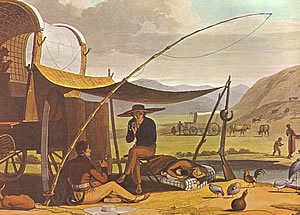 In 1835 Piet Retief, who had lost everything on his farm during the previous year's war and who had also failed in a business venture in Grahamstown, decided to quit the colony.
In 1835 Piet Retief, who had lost everything on his farm during the previous year's war and who had also failed in a business venture in Grahamstown, decided to quit the colony.
Drought conditions, the presence of the Xhosa to the east and dislike of British rule (or perhaps any rule) led numerous other boers in the area to join him.
During this period much of the land around the present village was occupied by farmers, many of whose descendants still occupy the same farms.
The Frontier wars of 1846 and 1850
A further invasion of Xhosa in 1846 caused much loss of livestock and destruction of property but even greater damage was done in an eighteen month war which started in December 1850.
In 1854, one of the leading inhabitants of the district, then in England, conceived the plan and laid out the erven for the village which he named after his good friend, the Duke of Bedford.
During the South African War of 1899 to 1902, there were two brief raids into the area by boer commandos which came under attack from local militia and British regulars.
Since it's foundation, the village has prospered as has the district, becoming a prime livestock farming area.